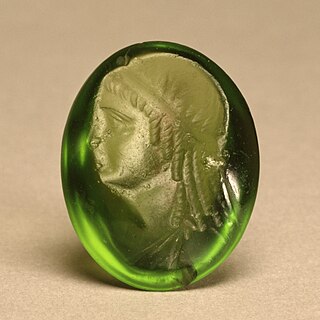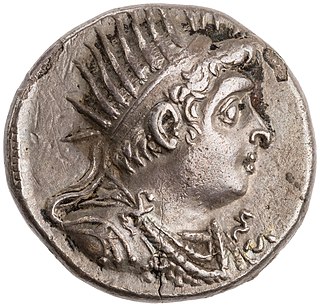
The Ptolemaic dynasty, also known as the Lagid dynasty, was a Macedonian Greek royal house which ruled the Ptolemaic Kingdom in Ancient Egypt during the Hellenistic period. Reigning for 275 years, the Ptolemaic was the longest and last dynasty of ancient Egypt from 305 BC until its incorporation into the Roman Republic in 30 BC.

Year 27 BC was either a common year starting on Sunday, Monday or Tuesday or a leap year starting on Monday of the Julian calendar and a common year starting on Sunday of the Proleptic Julian calendar. At the time, it was known as the Year of the Second Consulship of Octavian and Agrippa. The denomination 27 BC for this year has been used since the early medieval period, when the Anno Domini calendar era became the prevalent method in Europe for naming years.
This article concerns the period 39 BC – 30 BC.

This article concerns the period 49 BC – 40 BC.
This article concerns the period 29 BC – 20 BC.
This article concerns the period 119 BC – 110 BC.
Year 36 BC was either a common year starting on Tuesday, Wednesday or Thursday or a leap year starting on Wednesday of the Julian calendar and a common year starting on Wednesday of the Proleptic Julian calendar. At the time, it was known as the Year of the Consulship of Poplicola and Nerva. The denomination 36 BC for this year has been used since the early medieval period, when the Anno Domini calendar era became the prevalent method in Europe for naming years.
Year 130 BC was a year of the pre-Julian Roman calendar. At the time it was known as the Year of the Consulship of Lentulus/Pulcher and Perperna and the Fifth Year of Yuanguang. The denomination 130 BC for this year has been used since the early medieval period, when the Anno Domini calendar era became the prevalent method in Europe for naming years.

Cleopatra II Philometor Soteira was a queen of Ptolemaic Egypt who ruled from 175 to 115 BC with two successive brother-husbands and her daughter—often in rivalry with her brother Ptolemy VIII.

Ptolemy VII Neos Philopator was, ostensibly, a Ptolemaic king of Egypt. His identity and reign are controversial, and it is likely that he did not reign at all, but was only granted royal dignity posthumously. Depending on the historical reconstruction, he was a son of Cleopatra II of Egypt by either Ptolemy VI Philometor or Ptolemy VIII Physcon, with current scholarship leaning toward the second option.

Cleopatra I or Cleopatra Thea, surnamed Eueteria was a ruler of the Hellenistic Seleucid Empire. She was queen consort of Syria from 150 to about 125 BC as the wife of three Syrian kings: Alexander Balas, Demetrius II Nicator, and Antiochus VII Sidetes. She ruled Syria from 125 BC after the death of Demetrius II Nicator, eventually in co-regency with her son Antiochus VIII Grypus until 121 or 120 BC.

Ptolemy XII Neos Dionysus was a king of the Ptolemaic Kingdom of Egypt who ruled from 80 to 58 BC and then again from 55 BC until his death in 51 BC. He was commonly known as Auletes, referring to his love of playing the flute in Dionysian festivals. A member of the Ptolemaic dynasty, he was a descendant of its founder Ptolemy I, a Macedonian Greek general and companion of Alexander the Great.

Ptolemy VIII Euergetes II Tryphon, nicknamed Physcon, was a king of the Ptolemaic dynasty in Egypt. He was the younger son of King Ptolemy V and Queen Cleopatra I. His reign was characterised by fierce political and military conflict with his older siblings, Ptolemy VI and Cleopatra II.

Ptolemy IX Soter II, commonly nicknamed Lathyros, was twice King of Ptolemaic Egypt. He was the son of Ptolemy VIII and Cleopatra III. He reigned as Ptolemy Philometor Soter in joint rule with his grandmother Cleopatra II and mother Cleopatra III from 116 to 107 BC, and then again as Ptolemy Soter from 88 to 81 BC.

Ptolemy X Alexander I was the Ptolemaic king of Cyprus from 114 BC until 107 BC and of Egypt from 107 BC until his death in 88 BC. He ruled in co-regency with his mother Cleopatra III as Ptolemy Philometor Soter until 101 BC, and then with his niece and wife Berenice III as Ptolemy Philadelphus. He was a son of Ptolemy VIII and Cleopatra III, and younger brother of Ptolemy IX. His birth name was probably Alexander.
Cleopatra IV was Queen of Egypt briefly from 116 to 115 BC, jointly with her husband Ptolemy IX Lathyros. She later became queen consort of the Seleucid king of Syria as the wife of Antiochus IX Cyzicenus.

Cleopatra Selene was the Queen consort of Egypt from 115 to 102 BC, the Queen consort of Syria from 102–92 BC, and the monarch of Syria from 82 to 69 BC. The daughter of Ptolemy VIII Physcon and Cleopatra III of Egypt, Cleopatra Selene was favoured by her mother and became a pawn in Cleopatra III's political manoeuvres. In 115 BC, Cleopatra III forced her son Ptolemy IX to divorce his sister-wife Cleopatra IV, and chose Cleopatra Selene as the new queen consort of Egypt. Tension between the king and his mother grew and ended with his expulsion from Egypt, leaving Cleopatra Selene behind; she probably then married the new king, her other brother Ptolemy X.

Cleopatra III was a queen of Egypt. She ruled at first with her mother Cleopatra II and husband Ptolemy VIII from 142 to 131 BC and again from 127 to 116 BC. She then ruled with her sons Ptolemy IX and Ptolemy X from 116 to 101 BC.
Tryphaena was a Ptolemaic princess. She married the Seleucid king Antiochus VIII Grypus and was queen of Syria.











